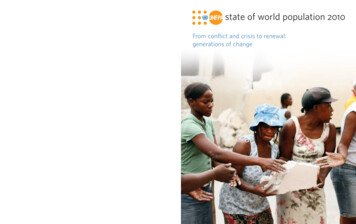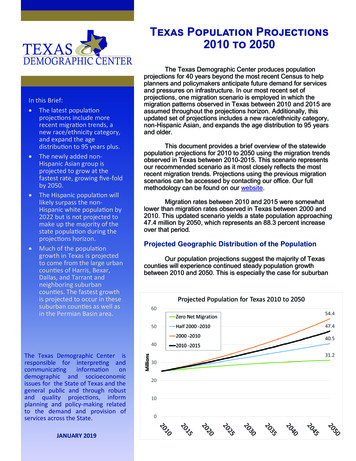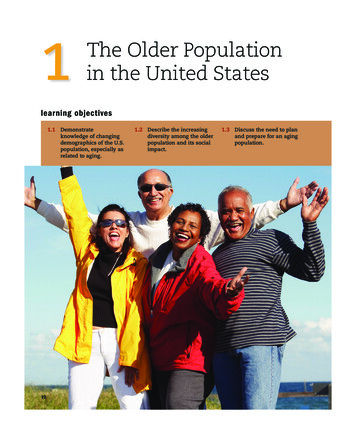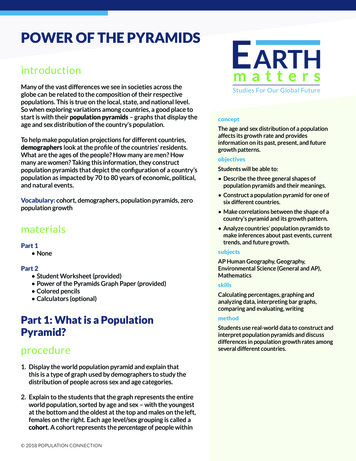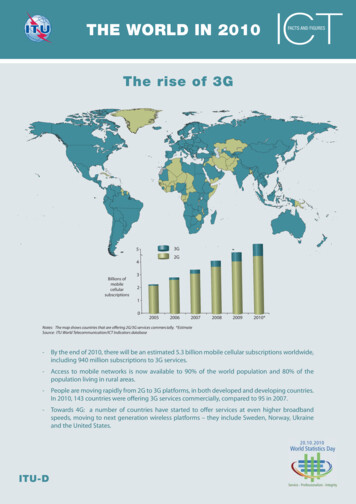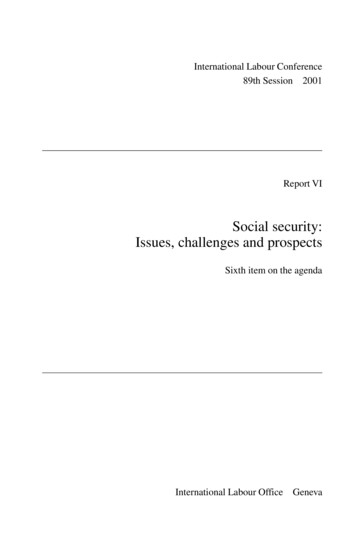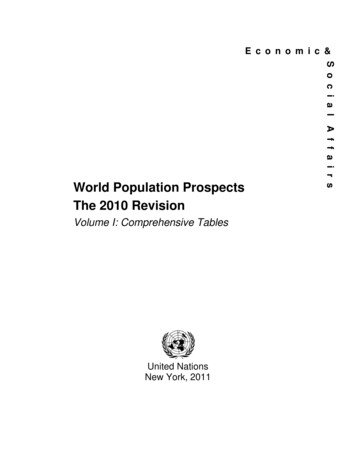
Transcription
E c o n o m i c &S o c i a lVolume I: Comprehensive TablesUnited NationsNew York, 2011A f f a i r sWorld Population ProspectsThe 2010 Revision
ST/ESA/SER.A/313Department of Economic and Social AffairsPopulation DivisionWorld Population ProspectsThe 2010 RevisionVolume I: Comprehensive TablesUnited NationsNew York, 2011
DESAThe Department of Economic and Social Affairs of the United NationsSecretariat is a vital interface between global policies in the economic, social andenvironmental spheres and national action. The Department works in threemain interlinked areas: (i) it compiles, generates and analyses a wide range ofeconomic, social and environmental data and information on which StatesMembers of the United Nations draw to review common problems and takestock of policy options; (ii) it facilitates the negotiations of Member States inmany intergovernmental bodies on joint courses of action to address ongoingor emerging global challenges; and (iii) it advises interested Governments on theways and means of translating policy frameworks developed in United Nationsconferences and summits into programmes at the country level and, throughtechnical assistance, helps build national capacities.NoteThe designations employed in this report and the material presented in it donot imply the expression of any opinion whatsoever on the part of theSecretariat of the United Nations concerning the legal status of any country,territory, city or area or of its authorities, or concerning the delimitation of itsfrontiers or boundaries.Symbols of United Nations documents are composed of capital letterscombined with figures.This publication has been issued without formal editing.Suggested citation:United Nations, Department of Economic and Social Affairs, PopulationDivision (2011). World Population Prospects: The 2010 Revision, Volume I:Comprehensive Tables. ST/ESA/SER.A/313.
PREFACEThis report presents the highlights of the results of the 2010 Revision of the official United Nationspopulation estimates and projections prepared by the Population Division of the Department ofEconomic and Social Affairs of the United Nations Secretariat. The 2010 Revision constitutes thetwenty second round of the global population estimates and projections produced by the PopulationDivision since 1951.The 2010 Revision breaks new ground in the production of population projections. It is the firststandard Revision to include projections up to 2100 for all countries and areas of the world. PreviousRevisions presented country projections only for the period ending in 2050. In order to extend theprojection period to 2100, a new method for the projection of fertility had to be developed. Themethod used in the 2010 Revision is based on the advances made in projecting fertility since the2000 Revision, advances that have been combined with a probabilistic approach to yield the futurepaths of fertility used in producing the medium variant of the 2010 Revision. The standard output ofthe 2010 Revision does not, however, include fully probabilistic projections. The standard output ofthe 2010 Revision includes only the usual projection variants and scenarios included in otherRevisions of World Population Prospects.The full results of the 2010 Revision are presented in two volumes. The first volume providescomprehensive tables displaying key demographic indicators for each development group, majorarea, region and country for selected periods or dates within 1950-2100. The second volume containsdemographic profiles presenting time series and plots covering the period from 1950 to 2100 forselected indicators for each country with at least 100,000 inhabitants in 2010 as well as fordevelopment groups, major areas and regions. This volume provides, for each country and area, abrief description of the data sources and demographic methods used to make the base-year estimatesfor each country or area. Key findings of the 2010 Revision are also included in each volumetogether with the projections assumptions, and a wall chart provides summary indicators for the mostrecent period.The detailed results of the 2010 Revision are made available through a variety of media. ThePopulation Division’s website provides access to the comprehensive data organized in Excel files aswell as to an interactive database allowing the user to obtain specific information on a few countriesat a time. The website can be accessed at www.unpopulation.org. Users requiring the completeresults of the 2010 Revision can purchase them on CD-ROM/DVD. A description of the datacontained in the different CD-ROMs available and an order form are posted on the PopulationDivision’s web site.Responsibility for the 2010 Revision rests with the Population Division. In preparing the 2010Revision, the Population Division relied on the collaboration of the regional commissions, especiallythe Economic Commission for Latin America and the Caribbean, and that of UNAIDS, thespecialized agencies and other relevant bodies of the United Nations system. The Statistics Divisionof the Department of Economic and Social Affairs of the United Nations Secretariat, through itsUnited Nations Demographic Yearbook and its accompanying databases, provided access to officialnational population statistics used in the preparation of the 2010 Revision. The Population Division isgrateful for the contributions made by all these entities.For further information about the 2010 Revision, please contact Ms. Hania Zlotnik, Director,Population Division, United Nations, New York, NY 10017, USA (Fax: 1 212 963 2147).iii
CONTENTSPagePreface . iiiExplanatory Notes . viiiExecutive Summary .xvChaptersI.WORLD POPULATION TRENDS .A. Population size and growth .B. Population age composition .113II.FERTILITY . 11III.MORTALITY AND THE DEMOGRAPHIC IMPACT OF HIV/AIDS. 17A. Trends and prospects in world mortality . 17B. The demographic impact of AIDS . 18IV.INTERNATIONAL MIGRATION. 25V.ASSUMPTIONS UNDERLYING THE 2010 REVISION .A. Fertility assumptions: convergence toward total fertility below replacement level .B. Mortality assumptions: increasing life expectancy except when affected by HIV/AIDS .C. International migration assumptions .D. Eight projection variants .E. Methodological changes introduced in the 2010 Revision.272735373738VI.ORDERING THE DATA ON CD-ROM . 41VII.LIST OF PREVIOUS REVISION. 77VIII.SUMMARY TABLES . opulation of the world, major development groups and major areas, 1950, 1975, 2011, 2050and 2100, according to different variants . 2Percentage distribution of the world population by development group and major area,estimates and projections according to different variants, 1950-2100 . 2Average annual rates of change of the population of the world and major areas, 1950-1980,51980-2011, 2011-2050 and 2050-2100 for different variants .Median age in years for the world and major areas, 1950, 1980, 2011, 2050 and 2100,according to different variants. 5Average annual rates of change of the total population and the population in broad age groupsby major area, 2011-2050 and 2050-2100. 7Distribution of the population of the world and major areas by broad age groups, 2010,2050 and 2100 (percentage) . 8Estimated and projected total fertility for the world, major development groups and major areas,1970-1975, 1990-1995, 2005-2010, 2045-2050 and 2095-2100 according to different variants . 11Distribution of the world population as well as countries and areas according to the level oftotal fertility in selected periods (medium variant) . 12iv
No.III.1.III.2.III.3.IV.1.V.1.PageLife expectancy at birth for the world, major development groups and major areas, 2005-2010and 2045-2050.Life expectancy by sex for the world and major development groups, 2005-2010 and2045-2050 .Difference in projected population in the medium variant versus a no-AIDS scenario for groupsof affected countries, 2010, 2015 and 2050 and 2100 .Average annual net number of migrants per decade by development group and major area,1950-2050 (medium variant) .Projection variants in terms of assumptions for fertility, mortality and international 11.12.13.14.PagePopulation of the world, 1950-2100, according to different projections and variants .Average annual rate of population change for the world and the major developmentgroups, 1950-2100.Total fertility trajectories for the world and the major development groups, 1950-2010 estimationand 2010-2100 projection (medium variant) .Life expectancy at birth for the world and the major development groups, 1950-2050 .Life expectancy at birth for the world and the major areas, 1950-2050 .Under-five mortality for the world and selected regions, 1950-2050.Percentage distribution of deaths by age, Southern Africa, 1985-1990 and 2005-2010 .Population in 2015, with AIDS and without AIDS, by sex and age group, Southern Africa .Schematic phases of the fertility transition .Total fertility decrements and projection intervals of double-logistic curves for Algeria .Probabilistic trajectories of projected total fertility (2010-2100) for Algeria .Total fertility decrements and projection intervals of double-logistic curves for Kenya .Probabilistic trajectories of projected total fertility (2010-2100) for Kenya (adjusted) .Probabilistic trajectories of projected total fertility (2010-2100) for Kazakhstan (adjusted) .xix4152122222323293031323334ANNEX TABLESSELECTED DEMOGRAPHIC INDICATORSPopulation size and al population at mid-year by major area and region: estimates and medium variant, 1950-2100.Total population at mid-year by major area and region: high variant, 2010-2100 .Total population at mid-year by major area and region: low variant, 2010-2100 .Total population at mid-year by major area and region: constant-fertility variant, 2010-2100.Average annual rate of population change by major area and region: estimates and mediumvariant, 1950-2100 .Average annual rate of population change by major area and region: high variant, 2010-2100 .Average annual rate of population change by major area and region: low variant, 2010-2100 .Average annual rate of population change by major area and region: constant-fertilityvariant, 2010-2100 .Total population at mid-year by major area, region and country: estimates and mediumvariant, 1950-2100 .Total population at mid-year by major area, region and country: high variant, 2010-2100 .v146148149150152154155156158168
al population at mid-year by major area, region and country: low variant, 2010-2100 .Total population at mid-year by major area, region and country: constant-fertility variant,2010-2100 .Average annual rate of population change by major area, region and country: estimatesand medium variant, 1950-2100.Average annual rate of population change by major area, region and country: high variant,2010-2100 .Average annual rate of population change by major area, region and country: low variant,2010-2100 .Average annual rate of population change by major area, region and country:constant-fertility variant, 2010-2100 .Annual interpolated mid-year population by major area, region and country: estimates, 1995-2010 .Annual interpolated mid-year population by major area, region and country: mediumvariant, 2010-2030 .22.A.23.A.24.Crude birth rate by major area, region and country: estimates and medium variant, 1950-2100 .Crude birth rate by major area, region and country: estimates and high variant, 1950-2100 .Crude birth rate by major area, region and country: estimates and low variant, 1950-2100 .Total fertility by major area, region and country: estimates and medium variant, 1950-2100 .Total fertility by major area, region and country: estimates and high variant, 1950-2100 .Total fertility by major area, region and country: estimates and low variant, 1950-2100 29.A.30.Crude death rate by major area, region and country: estimates and medium variant, 1950-2100 .Crude death rate by major area, region and country: estimates and high variant, 1950-2100 .Crude death rate by major area, region and country: estimates and low variant, 1950-2100 .Life expectancy at birth by major area, region and country: estimates and projections, 1950-2100.Infant mortality rate by major area, region and country: estimates and projections, 1950-2100 .Under-five mortality by major area, region and country: estimates and projections 1995-2100 .294304314324356366Population age composition and dependency ratiosA.31.A.32.A.33Population by broad age group, major area, region and country: estimates and mediumvariant, 1950-2100 .Population in school ages by major area, region and country: estimates and mediumvariant, 1950-2100 .Dependency ratios by major area, region and country: estimates and medium variant, 1950-2100 .vi372412460
EXPLANATORY NOTESThe following symbols have been used in the tables throughout this report:Two dots (.) indicate that data are not available or are not reported separately.A hyphen (-) indicates that the item is not applicable.A minus sign (-) before a figure indicates a decrease.A full stop (.) is used to indicate decimals.Years given refer to 1 July.Use of a hyphen (-) between years, for example, 1995-2000, signifies the full period involved,from 1 July of the first year to 1 July of the second year.Numbers and percentages in tables do not necessarily add to totals because of rounding.References to countries, territories and areas:The designations employed and the material in this publication do not imply the expression of any opinionwhatsoever on the part of the Secretariat of the United Nations concerning the legal status of any country,territory or area or its authorities, or concerning the delimitation of its frontiers or boundaries.The designation “more developed” and “less developed” regions are intended for statistical purposes anddo not express a judgment about the stage reached by a particular country or area in the developmentprocess. The term “country” as used in this publication also refers, as appropriate, to territories or areas.More developed regions comprise all regions of Europe plus Northern America, Australia/New Zealandand Japan. Less developed regions comprise all regions of Africa, Asia (excluding Japan), and LatinAmerica and the Caribbean as well as Melanesia, Micronesia and Polynesia. Countries or areas in the moredeveloped regions are designated as “developed countries”. Countries or areas in the less developedregions are designated as “developing countries”.The least developed countries, as defined by the United Nations General Assembly in its resolutions(59/209, 59/210, 60/33, 62/97, 64/L.55) include 48 countries in 2011: 33 in Africa, 9 in Asia, 5 in Oceaniaand one in Latin America and the Caribbean. Those 48 countries are: Afghanistan, Angola, Bangladesh,Benin, Bhutan, Burkina Faso, Burundi, Cambodia, Central African Republic, Chad, Comoros, DemocraticRepublic of the Congo, Djibouti, Equatorial Guinea, Eritrea, Ethiopia, Gambia, Guinea, Guinea-Bissau,Haiti, Kiribati, Lao People's Democratic Republic, Lesotho, Liberia, Madagascar, Malawi, Mali,Mauritania, Mozambique, Myanmar, Nepal, Niger, Rwanda, Samoa, Săo Tomé and Príncipe, Senegal,Sierra Leone, Solomon Islands, Somalia, Sudan, Timor-Leste, Togo, Tuvalu, Uganda, United Republic ofTanzania, Vanuatu, Yemen and Zambia. These countries are also included in the less developed regions.The group denominated “other less developed countries” comprises all countries in the less developedregions minus the least developed countries.The term “sub-Saharan Africa” is used to designate the countries in Africa that exclude those in NorthernAfrica but include Sudan.Countries and areas are grouped geographically into six major areas designated as: Africa; Asia; Europe;Latin America and the Caribbean; Northern America, and Oceania. These major areas are further dividedinto 21 geographical regions.The names and composition of geographical areas follow those presented in “Standard country or areacodes for statistical use” (ST/ESA/STAT/SER.M/49/Rev.3), available ii
The following abbreviations have been used:AIDSAcquired immunodeficiency syndromeARTAntiretroviral therapyDESADepartment of Economic and Social AffairsHIVHuman immunodeficiency virusMDGsMillennium Development GoalsSARSpecial Administrative RegionUNAIDS Joint United Nations Programme on HIV/AIDSviii
CLASSIFICATION OF COUNTRIES BY MAJOR AREAAND REGION OF THE WORLDAfricaEastern AfricaMiddle AfricaNorthern AfricaWestern dagascarMalawiMauritius UgandaUnited Republic ofTanzania 4ZambiaZimbabweAngolaCameroonCentral African RepublicChadCongoDemocratic Republic of theCongoEquatorial GuineaGabonSão Tomé and PríncipeAlgeriaEgyptLibyan Arab JamahiriyaMoroccoSudan 1TunisiaWestern SaharaBeninBurkina FasoCape VerdeCôte iMauritaniaNigerNigeriaSaint Helena 3 *SenegalSierra LeoneSouthern AfricaBotswanaLesothoNamibiaSouth AfricaSwazilandTogo1Including Southern Sudan which voted in favor of independence, but was not an official UN Member State as of May 2011Including Agalega, Rodrigues, and Saint Brandon.3Including Ascension, and Tristan da Cunha.4Including Zanzibar.2ix
CLASSIFICATION OF COUNTRIES (continued)AsiaEastern Asia5South-Central Asia6South-Eastern AsiaWestern AsiaBrunei DarussalamCambodiaIndonesiaLao People’s DemocraticRepublicMalaysia et NamArmeniaAzerbaijan 9BahrainCyprus 11Georgia 12IraqIsraelJordanKuwaitLebanonOccupied PalestinianTerritory 14OmanQatarSaudi ArabiaSyrian Arab RepublicTurkeyUnited Arab EmiratesYemenCentral AsiaChina 7China, Hong Kong SAR 8China, Macao SAR 10Democratic People’sRepublic of KoreaJapanMongoliaRepublic of ekistanSouthern AsiaAfghanistanBangladeshBhutanIndiaIran (Islamic Republic of)Maldives 15NepalPakistanSri Lanka5Includes other non-specified areasThe regions Southern Asia and Central Asia are combined into South-Central Asia.7For statistical purposes, the data for China do not include Hong Kong and Macao, Special Administrative Regions (SAR) ofChina.8As of 1 July 1997, Hong Kong became a Special Administrative Region (SAR) of China.9Including Nagorno-Karabakh.10As of 20 December 1999, Macao became a Special Administrative Region (SAR) of China.11Including Northern-Cyprus.12Including Abkhazia and South Ossetia13Including Sabah and Sarawak.14Including East Jerusalem.15Including Transnistria.6x
CLASSIFICATION OF COUNTRIES (continued)EuropeSouthern EuropeEastern EuropeNorthern EuropeBelarusBulgariaCzech RepublicHungaryPolandRepublic of MoldovaRomaniaRussian FederationSlovakiaUkraineChannel Islands 16DenmarkEstoniaFaeroe Islands*Finland 17IcelandIrelandIsle of Man*LatviaLithuaniaNorway 19SwedenUnited Kingdom of GreatBritain and NorthernIreland 21AlbaniaAndorra*Bosnia and HerzegovinaCroatiaGibraltar*GreeceHoly See 18 *ItalyMaltaMontenegroPortugalSan Marino*Serbia 20SloveniaSpain 22The former YugoslavRepublic of Macedonia 2316Refers to Guernsey, and Jersey.Including Åland Islands.18Refers to the Vatican City State.19Including Svalbard and Jan Mayen Islands.20Including Kosovo.21Also referred to as United Kingdom.22Including Canary Islands, Ceuta and Melilla23Also referred to as TFYR Macedonia.17xiWestern embourgMonaco*NetherlandsSwitzerland
CLASSIFICATION OF COUNTRIES (continued)Latin America and the CaribbeanCaribbeanCentral AmericaSouth AmericaAnguilla*Antigua and Barbuda*ArubaBahamasBarbadosBritish Virgin Islands*Cayman Islands*CubaDominica*Dominican RepublicGrenadaGuadeloupe 24HaitiJamaicaMartiniqueMontserrat*Netherlands Antilles 25Puerto RicoSaint Kitts and Nevis*Saint LuciaSaint Vincent and theGrenadinesTrinidad and TobagoTurks and Caicos Islands*United States VirginIslandsBelizeCosta RicaEl ntinaBoliviaBrazilChileColombiaEcuadorFalkland Islands (Malvinas)*French GuianaGuyanaParaguayPeruSurinameUruguayVenezuela (Bolivarian Rep. of)2425Including Saint-Barthélemy and Saint-Martin (French part).Refers to Curaçao, Sint Maarten (Dutch part), Bonaire, Saba and Sint Eustatiusxii
CLASSIFICATION OF COUNTRIES (continued)Northern AmericaBermuda*CanadaGreenland*Saint Pierre and Miquelon*United States of AmericaOceaniaAustralia/New ZealandMelanesiaMicronesiaPolynesia 26Australia 27New ZealandFijiNew CaledoniaPapua New GuineaSolomon IslandsVanuatuGuamKiribati*Marshall Islands*Micronesia(Federated States of)Nauru*Northern Mariana Islands*Palau*American Samoa*Cook Islands*French PolynesiaNiue*SamoaTokelau*TongaTuvalu*Wallis and Futuna Islands*Sub-Saharan AfricaAngolaBeninBotswanaBurkina FasoBurundiCameroonCape VerdeCentral African RepublicChadComorosCongoCôte d'IvoireDemocratic Republicof the CongoDjiboutiEquatorial RéunionRwandaSaint HelenaSão Tomé and PríncipeSenegalSeychellesSierra LeoneSomaliaSouth AfricaNOTE: Countries with a population of less than 100,000 in 2010 are indicated by an asterisk (*).2627Including Pitcairn.Including Christmas Island, Cocos (Keeling) Islands, and Norfolk Island.xiiiSudanSwazilandTogoUgandaUnited Republicof TanzaniaZambiaZimbabwe
EXECUTIVE SUMMARYThe 2010 Revision is the twenty second round of official United Nations population estimates andprojections prepared by the Population Division of the Department of Economic and Social Affairs of theUnited Nations Secretariat. These are used throughout the United Nations system as the basis foractivities requiring population information. The 2010 Revision builds on the 2008 Revision andincorporates the results of the 2000 and 2010 round of national population censuses as well as of recentspecialized surveys carried around the world. These sources provide both demographic and otherinformation to assess the progress made in achieving the internationally agreed development goals,including the Millennium Development Goals (MDGs). The comprehensive review of past worldwidedemographic trends and future prospects presented in the 2010 Revision provides the population basis forthe assessment of those goals.According to the 2010 Revision of the official United Nations population estimates and projections,the world population is projected to reach 7 billion in late 2011, surpass 9 billion people by 2050 andexceed 10 billion in 2100 (figure 1).Most of the additional 3 billion people from now to 2100 will enlarge the population of developingcountries, which is projected to rise from 5.7 billion in 2011 to 8.0 billion in 2050 and to 8.8 billion in2100, and will be distributed over the whole period among the population aged 15-59 (1.2 billion) and 60or over (1.9 billion) because the number of children under age 15 in developing countries will decrease.In contrast, the population of the more developed regions is expected to change minimally, passingfrom 1.24 billion in 2011 to 1.34 billion in 2100, and would have declined to 1.11 billion were it not forthe projected net migration from developing to developed countries, which is projected to average 2.2million persons annually from 2011 to 2050 and 0.8 million from 2050 to 2100.The results of the 2010 Revision incorporate the findings of the most recent national populationcensuses and of numerous specialized population surveys carried out around the world. The 2010Revision provides the demographic data and indicators to assess trends at the global, regional and nationallevels and to calculate many other key indicators commonly used by the United Nations system.Population in developing countries still youngCurrently the population of the less developed regions is still young, with children under age 15accounting with 29 per cent of the population and young persons aged 15 to 24 accounting for a further18 per cent. In fact, the numbers of children and young people in the less developed regions are at an alltime high (1.6 billion children and 1.0 billion young people), posing a major challenge for their countries,which are faced with the necessity of providing education or emplo
The 2010 Revision breaks new ground in the production of population projections. It is the first . United Nations Demographic Yearbook and its accompanying databases, provided access to official

